seats CADILLAC DEVILLE 2003 8.G Owners Manual
[x] Cancel search | Manufacturer: CADILLAC, Model Year: 2003, Model line: DEVILLE, Model: CADILLAC DEVILLE 2003 8.GPages: 423, PDF Size: 2.91 MB
Page 1 of 423

Seats and Restraint Systems........................... 1-1
Front Seats
............................................... 1-2
Rear Seats
............................................... 1-8
Safety Belts
.............................................. 1-9
Child Restraints
.......................................1-29
Air Bag Systems
......................................1-49
Restraint System Check
............................1-60
Features and Controls..................................... 2-1
Keys
........................................................ 2-3
Doors and Locks
....................................... 2-8
Windows
.................................................2-15
Theft-Deterrent Systems
............................2-19
Starting and Operating Your Vehicle
...........2-23
Mirrors
....................................................2-40
OnStar
žSystem
......................................2-45
HomeLinkžTransmitter
.............................2-47
Storage Areas
.........................................2-51
Sunroof
..................................................2-54
Vehicle Personalization
.............................2-55
Instrument Panel............................................. 3-1
Instrument Panel Overview
.......................... 3-4
Climate Controls
......................................3-29
Warning Lights, Gages and Indicators
.........3-40
Driver Information Center (DIC)
..................3-57
Trip Computer
.........................................3-79Audio System(s)
.......................................3-80
Driving Your Vehicle....................................... 4-1
Your Driving, the Road, and Your Vehicle
..... 4-2
Towing
...................................................4-31
Service and Appearance Care.......................... 5-1
Service
..................................................... 5-3
Fuel
......................................................... 5-4
Checking Things Under
the Hood
.............................................5-10
Headlamp Aiming
.....................................5-49
Bulb Replacement
....................................5-53
Windshield Wiper Blade Replacement
.........5-59
Tires
......................................................5-60
Appearance Care
.....................................5-84
Vehicle Identi®cation
.................................5-92
Electrical System
......................................5-93
Capacities and Speci®cations
...................5-101
Normal Maintenance Replacement Parts
....5-103
Maintenance Schedule..................................... 6-1
Maintenance Schedule
................................ 6-2
Customer Assistance Information.................... 7-1
Customer Assistance Information
.................. 7-2
Reporting Safety Defects
...........................7-10
Index................................................................ 1
2003 Cadillac DeVille Owner ManualM
Page 4 of 423

Vehicle Damage Warnings
Also, in this book you will ®nd these notices:
Notice:These mean there is something that could
damage your vehicle.
A notice will tell you about something that can damage
your vehicle. Many times, this damage would not be
covered by your warranty, and it could be costly. But the
notice will tell you what to do to help avoid the damage.
When you read other manuals, you might see CAUTION
and NOTICE warnings in different colors or in different
words.
You'll also see warning labels on your vehicle. They use
the same words, CAUTION or NOTICE.
Vehicle Symbols
Your vehicle has components and labels that use
symbols instead of text. Symbols, used on your vehicle,
are shown along with the text describing the operation
or information relating to a speci®c component, control,
message, gage or indicator.
If you need help ®guring out a speci®c name of a
component, gage or indicator, reference the following
topics:
·Seats and Restraint Systems in Section 1
·Features and Controls in Section 2
·Instrument Panel Overview in Section 3
·Climate Controls in Section 3
·Warning Lights, Gages and Indicators in Section 3
·Audio System(s) in Section 3
·Engine Compartment Overview in Section 5
iv
Page 7 of 423

Front Seats......................................................1-2
Power Seats..................................................1-2
Power Lumbar...............................................1-2
Massaging Lumbar.........................................1-3
Adaptive Seat Control.....................................1-3
Heated Seats.................................................1-4
Reclining Seatbacks........................................1-5
Head Restraints.............................................1-7
Rear Seats.......................................................1-8
Power Lumbar...............................................1-8
Safety Belts.....................................................1-9
Safety Belts: They Are for Everyone.................1-9
Questions and Answers About Safety Belts......1-13
How to Wear Safety Belts Properly.................1-14
Driver Position..............................................1-14
Safety Belt Use During Pregnancy..................1-20
Right Front Passenger Position.......................1-21
Center Front Passenger Position.....................1-21
Rear Seat Passengers..................................1-22
Rear Safety Belt Comfort Guides
for Children and Small Adults......................1-26
Safety Belt Pretensioners...............................1-28
Safety Belt Extender.....................................1-28Child Restraints.............................................1-29
Older Children..............................................1-29
Infants and Young Children............................1-32
Child Restraint Systems.................................1-35
Where to Put the Restraint.............................1-38
Top Strap....................................................1-39
Top Strap Anchor Location.............................1-41
Lower Anchorages and Top Tethers for
Children (LATCH System)...........................1-41
Securing a Child Restraint Designed for the
LATCH System.........................................1-43
Securing a Child Restraint in a Rear Seat
Position...................................................1-44
Securing a Child Restraint in the Right Front
Seat Position............................................1-46
Air Bag Systems............................................1-49
Where Are the Air Bags?...............................1-52
When Should an Air Bag In¯ate?....................1-55
What Makes an Air Bag In¯ate?.....................1-56
How Does an Air Bag Restrain?.....................1-56
What Will You See After an Air Bag In¯ates? . . .1-57
Servicing Your Air Bag-Equipped Vehicle.........1-59
Restraint System Check..................................1-60
Checking Your Restraint Systems...................1-60
Replacing Restraint System Parts After
a Crash...................................................1-60
Section 1 Seats and Restraint Systems
1-1
Page 8 of 423
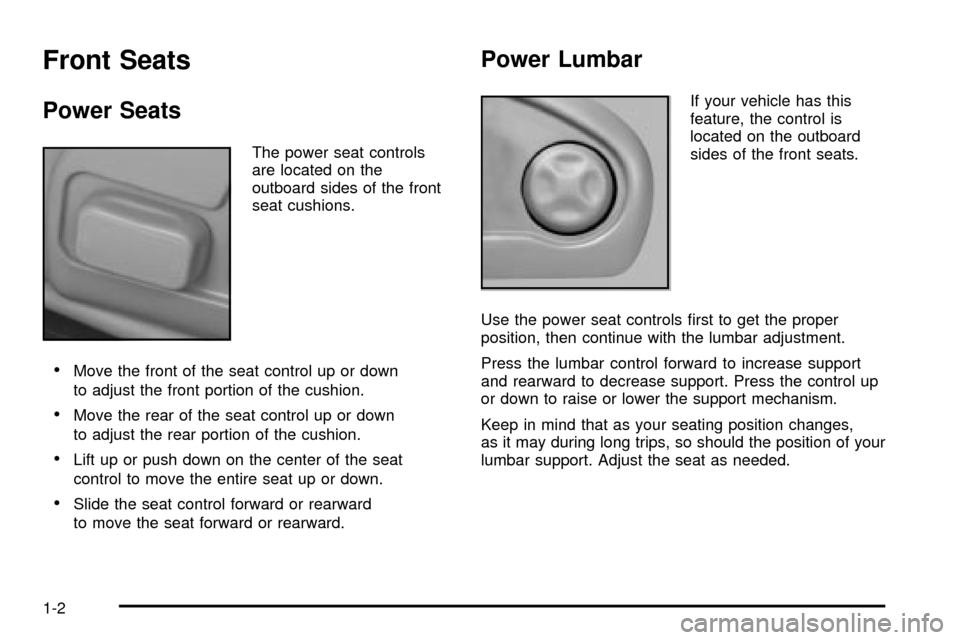
Front Seats
Power Seats
The power seat controls
are located on the
outboard sides of the front
seat cushions.
·Move the front of the seat control up or down
to adjust the front portion of the cushion.
·Move the rear of the seat control up or down
to adjust the rear portion of the cushion.
·Lift up or push down on the center of the seat
control to move the entire seat up or down.
·Slide the seat control forward or rearward
to move the seat forward or rearward.
Power Lumbar
If your vehicle has this
feature, the control is
located on the outboard
sides of the front seats.
Use the power seat controls ®rst to get the proper
position, then continue with the lumbar adjustment.
Press the lumbar control forward to increase support
and rearward to decrease support. Press the control up
or down to raise or lower the support mechanism.
Keep in mind that as your seating position changes,
as it may during long trips, so should the position of your
lumbar support. Adjust the seat as needed.
1-2
Page 9 of 423
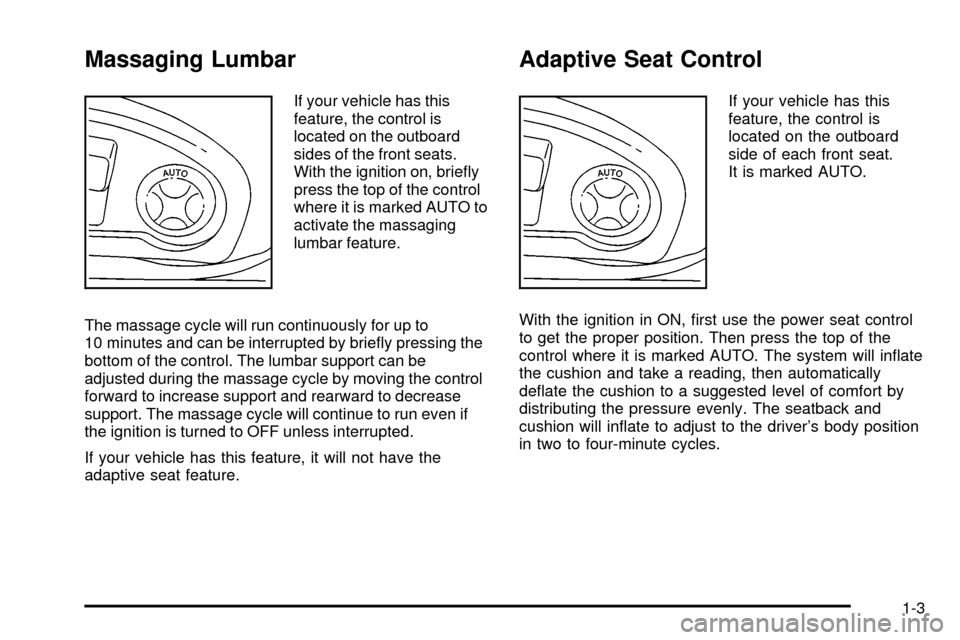
Massaging Lumbar
If your vehicle has this
feature, the control is
located on the outboard
sides of the front seats.
With the ignition on, brie¯y
press the top of the control
where it is marked AUTO to
activate the massaging
lumbar feature.
The massage cycle will run continuously for up to
10 minutes and can be interrupted by brie¯y pressing the
bottom of the control. The lumbar support can be
adjusted during the massage cycle by moving the control
forward to increase support and rearward to decrease
support. The massage cycle will continue to run even if
the ignition is turned to OFF unless interrupted.
If your vehicle has this feature, it will not have the
adaptive seat feature.
Adaptive Seat Control
If your vehicle has this
feature, the control is
located on the outboard
side of each front seat.
It is marked AUTO.
With the ignition in ON, ®rst use the power seat control
to get the proper position. Then press the top of the
control where it is marked AUTO. The system will in¯ate
the cushion and take a reading, then automatically
de¯ate the cushion to a suggested level of comfort by
distributing the pressure evenly. The seatback and
cushion will in¯ate to adjust to the driver's body position
in two to four-minute cycles.
1-3
Page 10 of 423
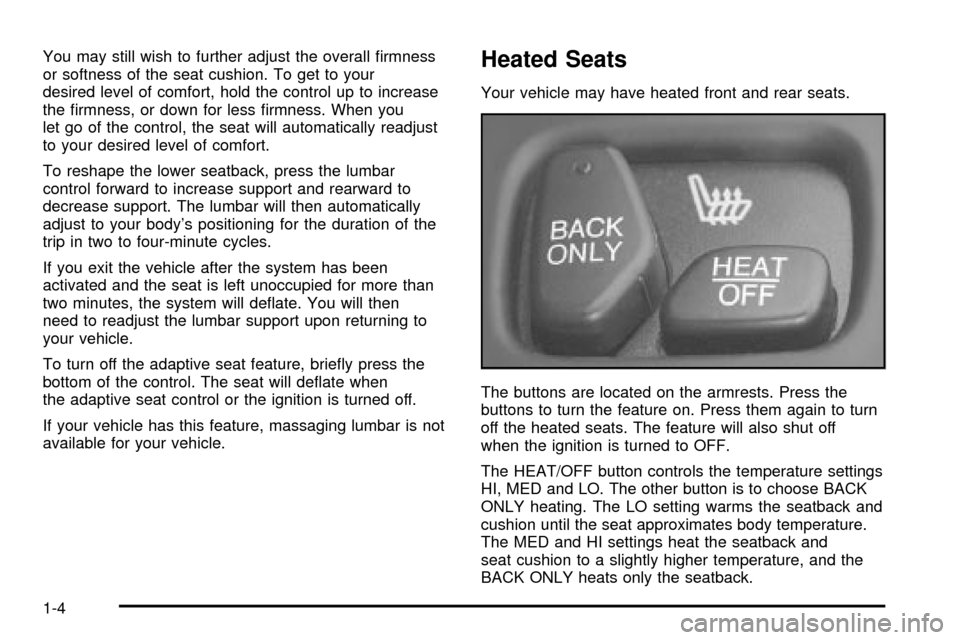
You may still wish to further adjust the overall ®rmness
or softness of the seat cushion. To get to your
desired level of comfort, hold the control up to increase
the ®rmness, or down for less ®rmness. When you
let go of the control, the seat will automatically readjust
to your desired level of comfort.
To reshape the lower seatback, press the lumbar
control forward to increase support and rearward to
decrease support. The lumbar will then automatically
adjust to your body's positioning for the duration of the
trip in two to four-minute cycles.
If you exit the vehicle after the system has been
activated and the seat is left unoccupied for more than
two minutes, the system will de¯ate. You will then
need to readjust the lumbar support upon returning to
your vehicle.
To turn off the adaptive seat feature, brie¯y press the
bottom of the control. The seat will de¯ate when
the adaptive seat control or the ignition is turned off.
If your vehicle has this feature, massaging lumbar is not
available for your vehicle.Heated Seats
Your vehicle may have heated front and rear seats.
The buttons are located on the armrests. Press the
buttons to turn the feature on. Press them again to turn
off the heated seats. The feature will also shut off
when the ignition is turned to OFF.
The HEAT/OFF button controls the temperature settings
HI, MED and LO. The other button is to choose BACK
ONLY heating. The LO setting warms the seatback and
cushion until the seat approximates body temperature.
The MED and HI settings heat the seatback and
seat cushion to a slightly higher temperature, and the
BACK ONLY heats only the seatback.
1-4
Page 11 of 423
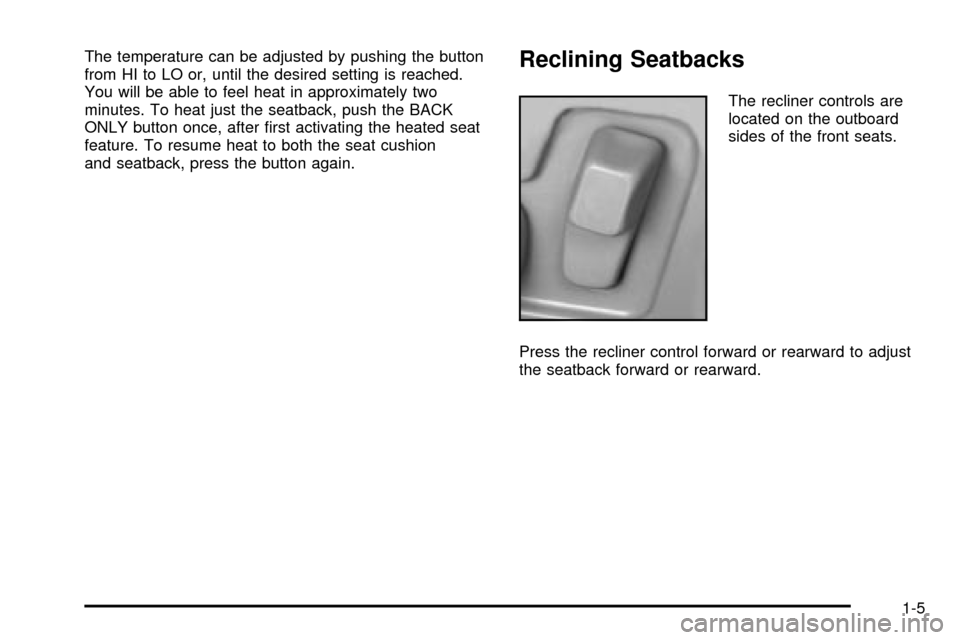
The temperature can be adjusted by pushing the button
from HI to LO or, until the desired setting is reached.
You will be able to feel heat in approximately two
minutes. To heat just the seatback, push the BACK
ONLY button once, after ®rst activating the heated seat
feature. To resume heat to both the seat cushion
and seatback, press the button again.Reclining Seatbacks
The recliner controls are
located on the outboard
sides of the front seats.
Press the recliner control forward or rearward to adjust
the seatback forward or rearward.
1-5
Page 14 of 423
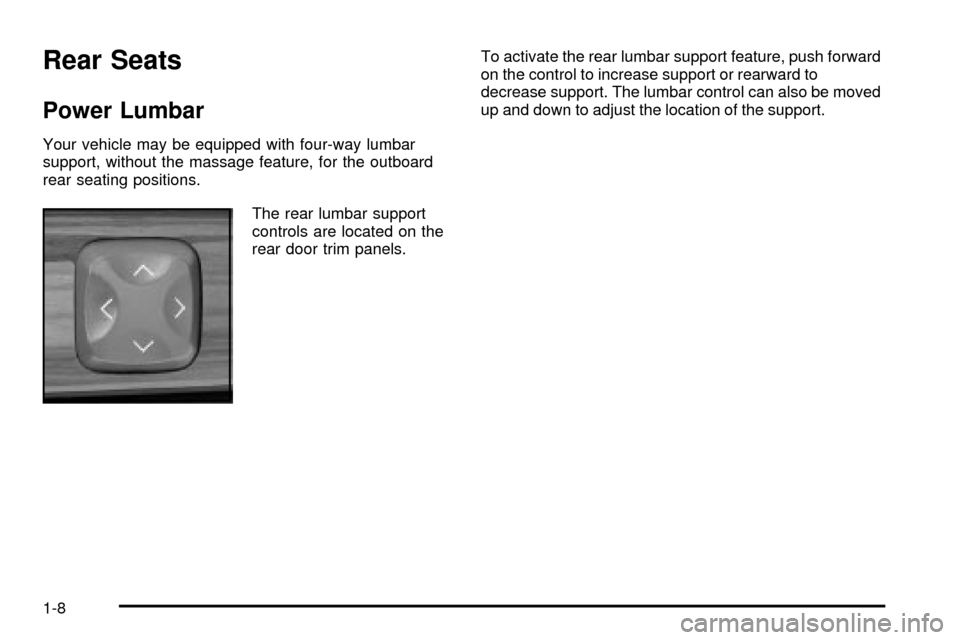
Rear Seats
Power Lumbar
Your vehicle may be equipped with four-way lumbar
support, without the massage feature, for the outboard
rear seating positions.
The rear lumbar support
controls are located on the
rear door trim panels.To activate the rear lumbar support feature, push forward
on the control to increase support or rearward to
decrease support. The lumbar control can also be moved
up and down to adjust the location of the support.
1-8
Page 15 of 423
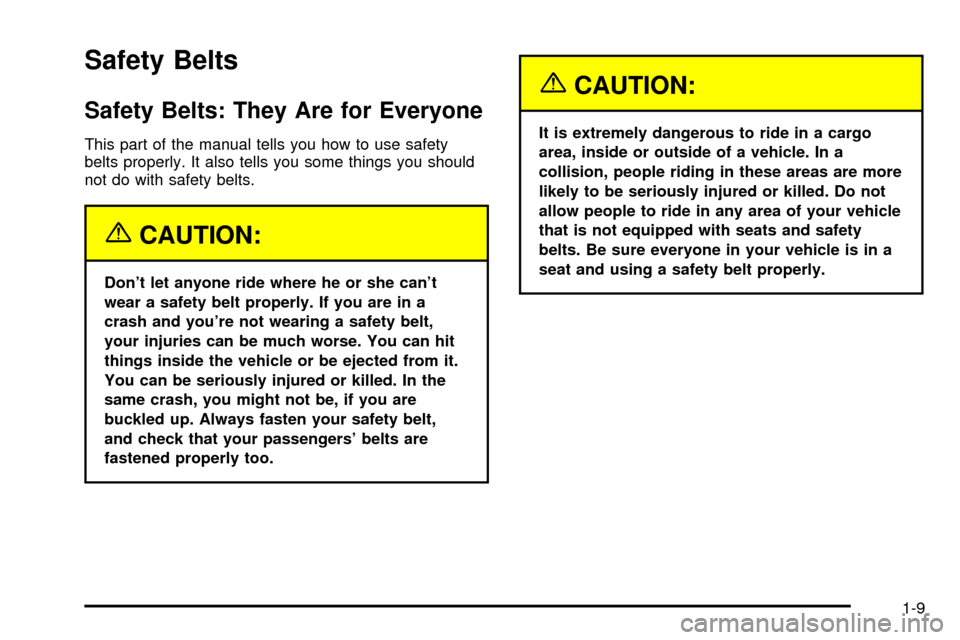
Safety Belts
Safety Belts: They Are for Everyone
This part of the manual tells you how to use safety
belts properly. It also tells you some things you should
not do with safety belts.
{CAUTION:
Don't let anyone ride where he or she can't
wear a safety belt properly. If you are in a
crash and you're not wearing a safety belt,
your injuries can be much worse. You can hit
things inside the vehicle or be ejected from it.
You can be seriously injured or killed. In the
same crash, you might not be, if you are
buckled up. Always fasten your safety belt,
and check that your passengers' belts are
fastened properly too.
{CAUTION:
It is extremely dangerous to ride in a cargo
area, inside or outside of a vehicle. In a
collision, people riding in these areas are more
likely to be seriously injured or killed. Do not
allow people to ride in any area of your vehicle
that is not equipped with seats and safety
belts. Be sure everyone in your vehicle is in a
seat and using a safety belt properly.
1-9
Page 20 of 423
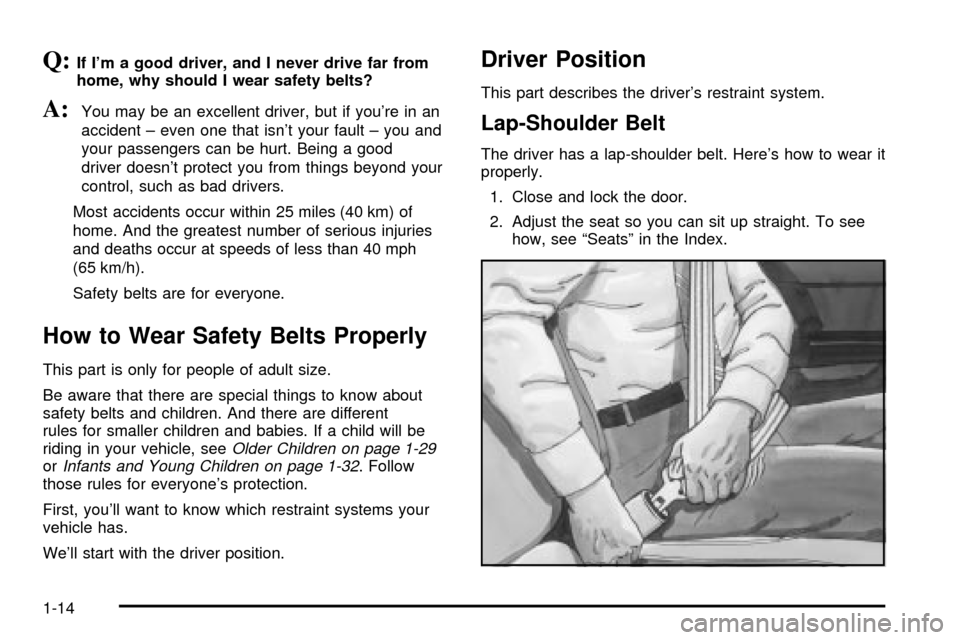
Q:If I'm a good driver, and I never drive far from
home, why should I wear safety belts?
A:You may be an excellent driver, but if you're in an
accident ± even one that isn't your fault ± you and
your passengers can be hurt. Being a good
driver doesn't protect you from things beyond your
control, such as bad drivers.
Most accidents occur within 25 miles (40 km) of
home. And the greatest number of serious injuries
and deaths occur at speeds of less than 40 mph
(65 km/h).
Safety belts are for everyone.
How to Wear Safety Belts Properly
This part is only for people of adult size.
Be aware that there are special things to know about
safety belts and children. And there are different
rules for smaller children and babies. If a child will be
riding in your vehicle, see
Older Children on page 1-29orInfants and Young Children on page 1-32. Follow
those rules for everyone's protection.
First, you'll want to know which restraint systems your
vehicle has.
We'll start with the driver position.
Driver Position
This part describes the driver's restraint system.
Lap-Shoulder Belt
The driver has a lap-shoulder belt. Here's how to wear it
properly.
1. Close and lock the door.
2. Adjust the seat so you can sit up straight. To see
how, see ªSeatsº in the Index.
1-14